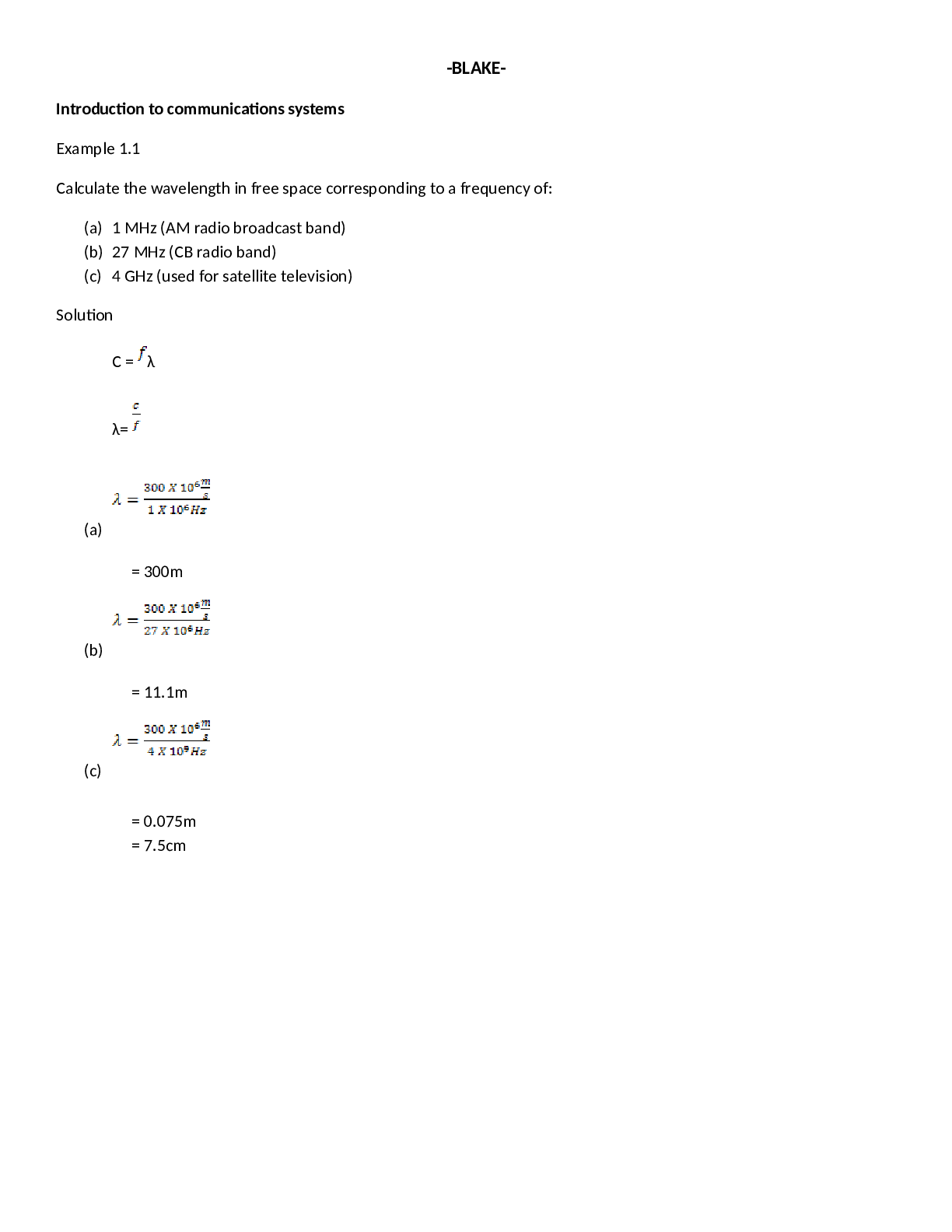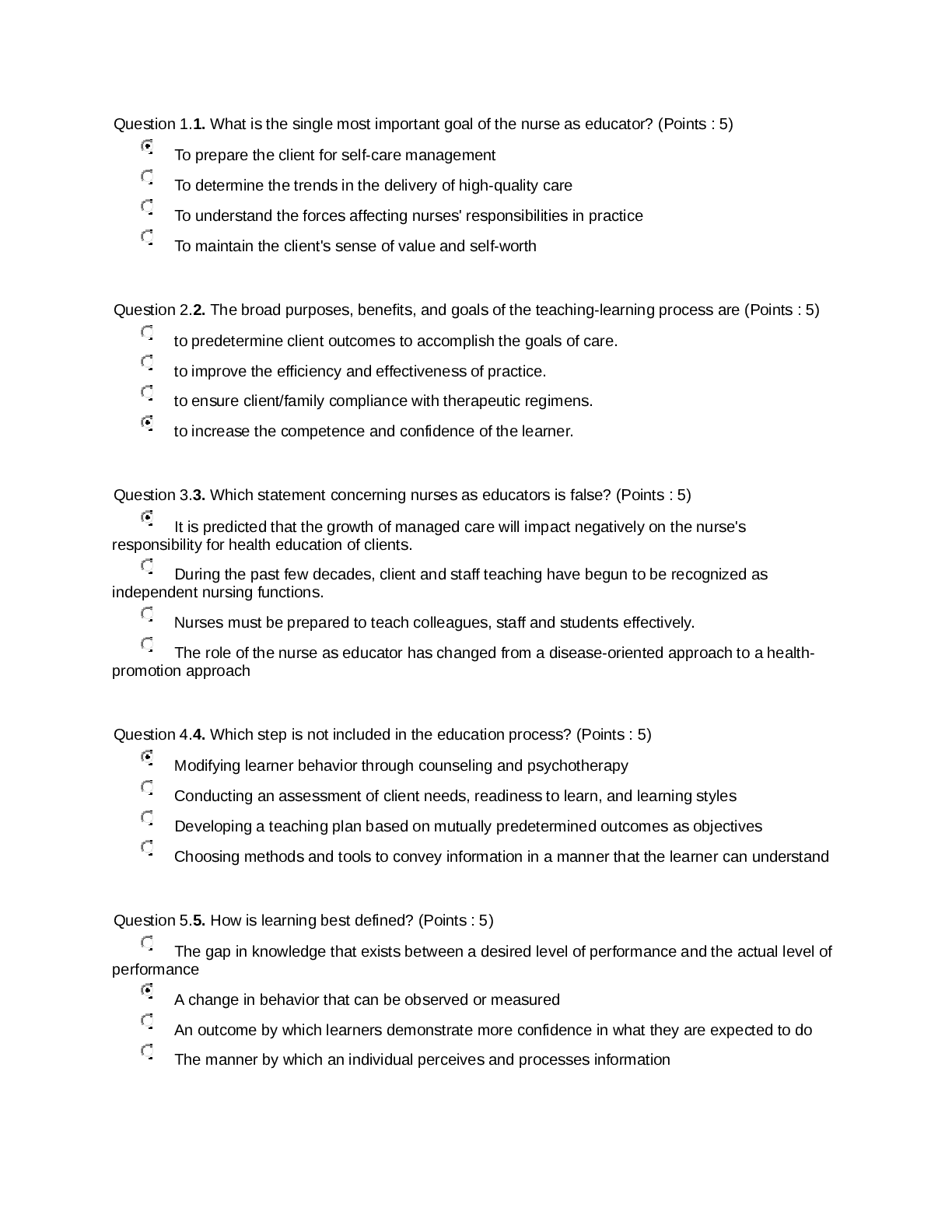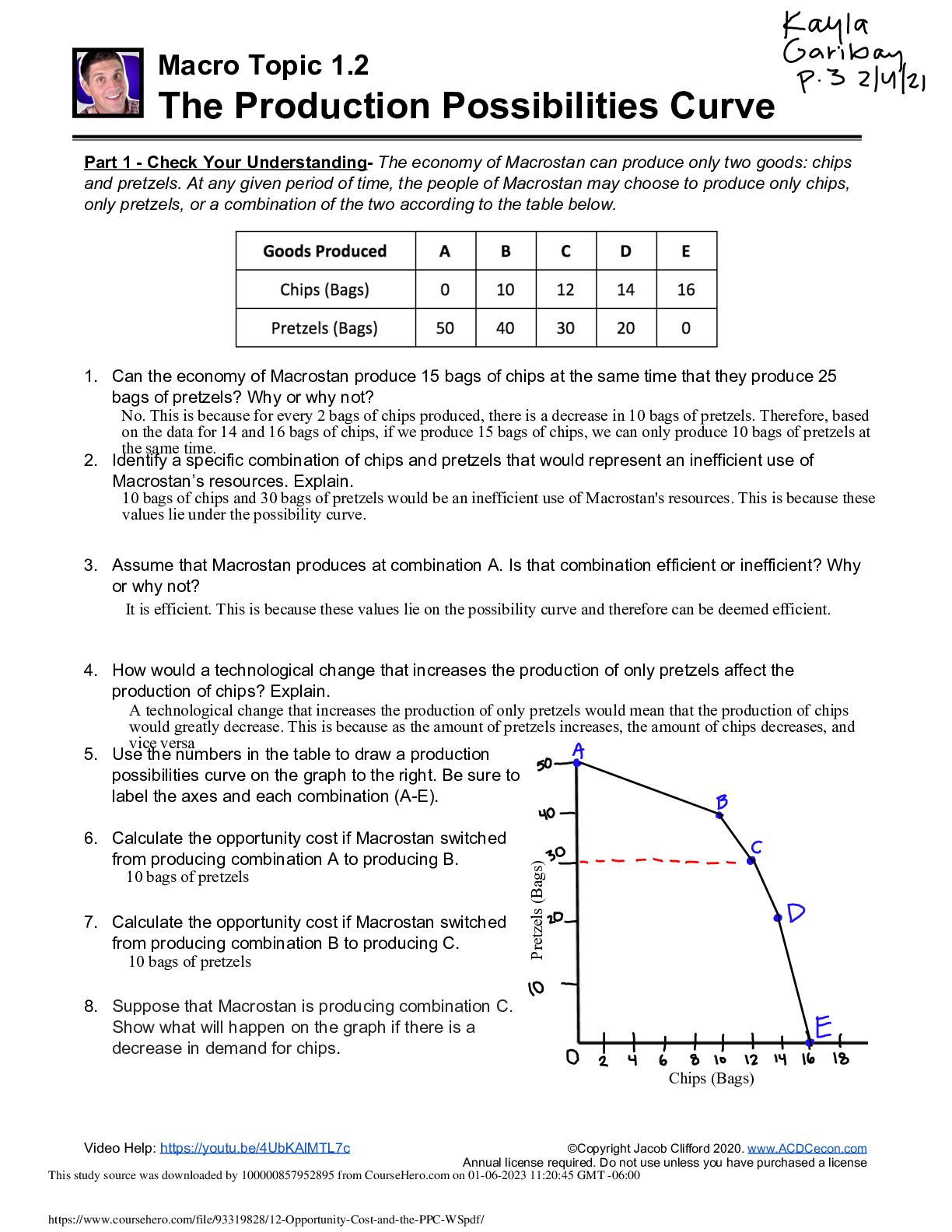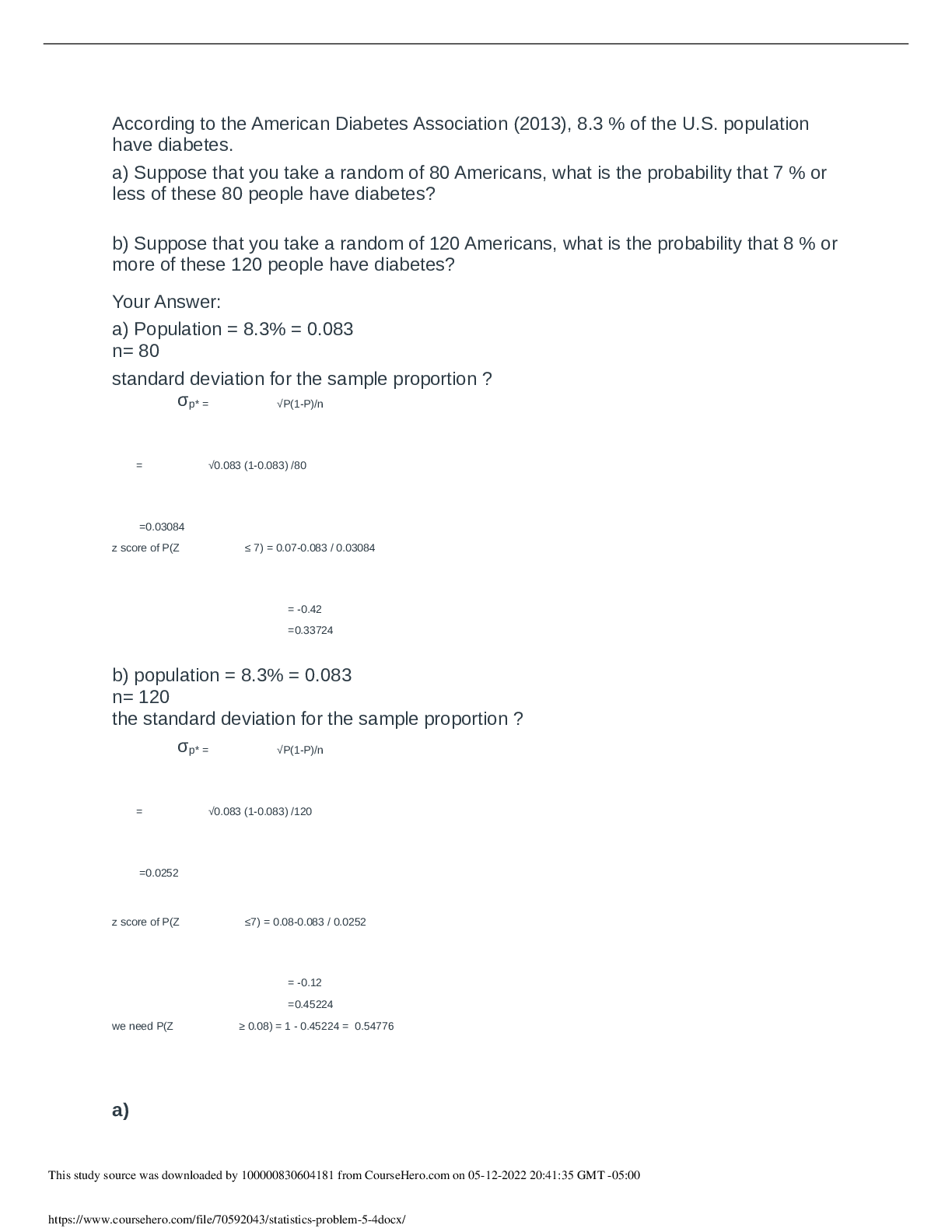Physics > QUESTIONS & ANSWERS > BLAKE - Introduction to communications systems -Questions and Answers (All)
BLAKE - Introduction to communications systems -Questions and Answers
Document Content and Description Below
-BLAKEIntroduction to communications systems Example 1.1 Calculate the wavelength in free space corresponding to a frequency of: (a) 1 MHz (AM radio broadcast band) (b) 27 MHz (CB radio band) (c)... 4 GHz (used for satellite television) Solution C = λ λ= (a) = 300m (b) = 11.1m (c) = 0.075m = 7.5cm Introduction to communications systems Example1.4 A receiver has a noise power bandwidth of 10 kHz. A resistor that matches the receiver input impedance is connected across its antenna terminals. What is the noise power contributed by that resistor in the receiver bandwidth, if the resistor has temperature of 27 ⁰C Solution T(K)= T (⁰C) + 273 = 27 + 273 = 300 K PN = kTB = (1.38 X 10-23 J/K (300 K) (10 X 103 Hz) = 4.14 X 10-17 W EXAMPLE 1.5 A 300Ω resistor is connected across the 300 Ω antenna input of a television receiver. The bandwidth of the receiver is 6 MHz, and the resistor is at room temperature (293 K or 20⁰C or 68⁰F). Find the noise power voltage applied to the receiver input. Solution PN = kTB = (1.38 X 10-23 J/K (300 K)(293 K) (6 X 103 Hz) = 24.2 X 10-15 W = 24.2 fW V N = √4kTBR = √4 (1.38 X 10-23 J/K)(293)(6 X 106 Hz) (300 Ω) = 5.4 X 10-6 V = 5.4µV Introduction to communications systems EXAPMLE 1.6 A diode noise generator is required to produce 10µV of noise in a receiver with an input impedance of 75 Ω, resistive, and a noise power bandwidth 0f 200 kHz. (These values are typical of FM broadcast receivers.) What must be current through the diode be? Solution V N I N = I N = √2qI0B R I 2 N = 2qI0B 10µV I 2 N = = 75 Ω 2qB = 0.133µA (0.133 X 10-6 A)2 = 2(1.6 X 10 -19 C)(200 X 103 Hz) = 0.276 A or 276 mA EXAMPLE 1.8 A receiver produces a noise power of 200 mW with no signal. The output level increases to 5W when a signal is applied. Calculate (S + N)/N as a power ratio and in decibels. Solution: 5 W (S+N)/N= 0.2 W = 25 (S+N)/N (dB) = 10 log 25 = 14dB EXAMPLE 1.9 The signal power at the input to an amplifier is 100µW. at the output, the signal power is 1W and the noise power is 30mW. What is the amplifier noise figure, as a ratio? Solution: 100µW 100 (S/N)i = = 100 NF (ratio) = = 3 1µW 33.5 1µW (S/N)o = = 33.3 0.03W Introduction to communications systems EXAMPLE 1.10 The signal at the input of an amplifier has an S/N of 42dB. If the amplifier has noise figure of 6dB, what is the S/N at the output (in decibel)? Solution NF (dB) = (S/N)i(dB) - (S/N)o(dB) (S/N)o(dB) = (S/N)i(dB) - NF (dB) = 42 dB – 6 dB = 36dB EXAMPLE 1.11 An amplifier has a noise figure of 2 dB. What is its equivalent noise temperature? Solution NF (dB) = 10 log NF (ratio) NF(dB) NF (ratio)= antilog 10 = antilog 0.2 = 1.585 Teq = 290 (NF – 1) = 290 (1.585 – 1) = 169.6 K Radio-Frequency Circuit EXAMPLE 2.5 A varactor has a maximum capacitance of 80pF and is used in a tuned circuit with a 100 µH inductor. (a) Find the resonant frequency with no tuning voltage applied (b) Find the tuning necessary for the circuit to resonate at double the frequency found in part (a) Solution (a) 1 0 = 2π√LC 1 = 2π√(100 X 10-6)(80 X 10-12) = 1.78 MHz (b) 1 C0 0 = C = 2π√LC √1+2V 1 C0 0 = √1+2V = 4π2√LC C 1 C0 2 0 = 1+2V = 4π2 2 0 L C 1 (C0/ C) 2-1 = V = 4π2 (2 X 1..78 X 106 ) 2 (100 X 10-6) 2 = 20 X 10-12 F (80/20) 2-1 = 20pF = 2 = 7.5 V Radio-Frequency Circuit EXAMPLE 2.6 A portable radio transmitter has to operate at temperature form – 50⁰C to 350⁰C if its signal is derived from a crystal oscillator with a temperature coefficient of +1 ppm/degree C and it transmits at exactly 146 MHz at 20⁰C, find the transmitting frequency at the two extremes of the operating temperature range. Solution T = 0 + k 0 (T – T0) max =146 MHz + (146 MHz)(1 X 10 -6 )(35 -20) = 146.00219 MHz min =146 MHz + (146 MHz)(1 X 10 -6 )(-5 -20) = 145.99635 MHz EXAMPLE 2.7 Sine – wave signals with frequencies of 10 MHz 11MHz are applied to square – law mixer. What frequencies appear at the output? Solution 1 = 11MHz 2 2 = 22MHz 1 + 2 =21 MHz 2 = 11MHz 2 2 = 20MHz 1 - 2 = 1 MHz EXAMPLE 2.8 A phase – locked loop has a VCO with a free – running frequency of 12 MHz. As the frequency of the reference input is gradually raised from zero, the loop locks at 10MHz and comes out of lock again at 16 MHz. (a) Find the capture range and lock range (b) Suppose that the experiment is repeated, but this time the reference input begins with a very high frequency and steadily moves downward. Predict the frequencies at which lock would be achieved and lost. Solution (a) (b) Capture range = 2(12 MHz – 10 MHz) 12 MHz + 2 MHz =14 MHz = 4 MHz 12 MHz – 4 MHz = 8 MHz lock range = 2(16 MHz – 12 MHz) = 8 MHz Radio-Frequency Circuit EXAMPLE 2.9 Configure a simple PLL synthesizer using a 10 MHz crystal so that it will generate the AM broadcast frequencies from 540 to 1700 kHz. Solution OSC Q= ref 10 MHz = 10 kHz = 1000 0 = N ref 0 N = ref 540 kHz N = 10 kHz = 54 1700 kHz N = 10 kHz = 170 Radio-Frequency Circuit EXAMPLE 2.10 The synthesizer in Figure 2.40 has P = 10 and ref =10 kHz. Find the minimum frequency step size and compare it with that obtained using a fixed divided-by-10 prescaler. Solution Step size = M ref = 10 X 10 kHz = 10 kHz 0 = (M+NP) ref = (M+NP)10 kHz ’0 = (M+1+NP) ref = (M+1+NP)10 kHz ’ 0 + 0 = (M+1+NP) 10 kHz – (M+NP)10kHz = (M+1+NP – M - NP) 10 kHz = 10kHz EXAMPLE 2.11 A synthesizer of the type shown in figure 2.42 has ref =20 kHz and local oscillator operating at 10 Mhz. Find the frequency range of the output as the value of N ranges from 10 to 100. Also find the minimum amount by which the frequency can be varied. [Show More]
Last updated: 2 years ago
Preview 1 out of 82 pages

Buy this document to get the full access instantly
Instant Download Access after purchase
Buy NowInstant download
We Accept:

Reviews( 0 )
$15.00
Can't find what you want? Try our AI powered Search
Document information
Connected school, study & course
About the document
Uploaded On
Dec 13, 2022
Number of pages
82
Written in
Additional information
This document has been written for:
Uploaded
Dec 13, 2022
Downloads
0
Views
44






.png)




.png)

.png)
.png)
.png)
.png)
.png)

